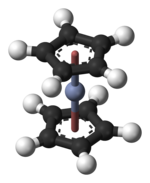Chromocene
| |||
| Names | |||
|---|---|---|---|
| IUPAC name
Bis(η5-cyclopentadienyl)chromium(II)
| |||
| Other names
Dicyclopentadienylchromium(II)
| |||
| Identifiers | |||
3D model (JSmol)
|
|||
| ChEBI | |||
| ChemSpider | |||
| ECHA InfoCard | 100.013.670 | ||
PubChem CID
|
|||
| RTECS number |
| ||
CompTox Dashboard (EPA)
|
|||
| |||
| |||
| Properties | |||
| C10H10Cr | |||
| Molar mass | 182.186 g·mol−1 | ||
| Appearance | dark red crystals | ||
| Density | 1.43 g/cm3 | ||
| Melting point | 168 to 170 °C (334 to 338 °F; 441 to 443 K) | ||
| Boiling point | Sublimes (under vacuum) | ||
| Insoluble | |||
| Structure | |||
| Pseudooctahedral see Ferrocene | |||
| 0 D | |||
| Hazards | |||
| Occupational safety and health (OHS/OSH): | |||
Main hazards
|
Pyrophoric | ||
| NFPA 704 (fire diamond) | |||
| Related compounds | |||
Related compounds
|
Fe(C5H5)2 Ni(C5H5)2 bis(benzene)chromium chromium(II) acetate | ||
Except where otherwise noted, data are given for materials in their standard state (at 25 °C [77 °F], 100 kPa).
| |||
Chromocene, formally known as bis(η5-cyclopentadienyl)chromium(II), is a chemical compound with the condensed structural formula [Cr(C5H5)2]. Each molecule contains an atom of chromium bound between two planar systems of five carbon atoms known as cyclopentadienyl (Cp) rings in a sandwich arrangement, which is the reason its formula is often abbreviated as Cp2Cr. It is an organometallic compound as it has (haptic) covalent chromium–carbon bonds.[1] Chromocene is structurally similar to ferrocene, the prototype for the metallocene class of compounds; however, as it has only 16 valence electrons, it does not follow the 18-electron rule.[2] It is a paramagnetic compound and also highly reducing, both consequences of its low valence electron count. Like structurally related metallocenes, chromocene readily sublimes in a vacuum and is soluble in non-polar organic solvents.
Ernst Otto Fischer, who shared the 1973 Nobel Prize in Chemistry for his work on sandwich compounds,[3] was the first to report a synthesis for chromocene.[4] One simple method of preparation involves the reaction of chromium(II) chloride with sodium cyclopentadienide:
- CrCl2 + 2 NaC5H5 → Cr(C5H5)2 + 2 NaCl
Such syntheses are typically conducted in THF; decamethylchromocene, Cr[C5(CH3)5]2, can be prepared analogously from LiC5(CH3)5. Chromocene can also be prepared from chromium(III) chloride in a redox process:[5]
- 2 CrCl3 + 6 NaC5H5 → 2 Cr(C5H5)2 + C10H10 + 6 NaCl
The chromium(0) organometallic complex chromium hexacarbonyl can be oxidised by cyclopentadiene in the presence of diethylamine to produce chromocene, the removed protons being reduced to produce hydrogen gas.[6]
- Cr(CO)6 + 2 C5H6 → Cr(C5H5)2 + 6 CO + H2
The structure of chromocene has been verified by X-ray crystallography; the average Cr–C bond length is 215.1(13) pm.[7]
Like some other metallocenes, the cyclopentadienyl ligands of chromocene are displaceable. When combined with silica gel, chromocene gives the Union Carbide catalyst for ethylene polymerization, although other synthetic routes exist for the formation of this important catalyst. The chromocene decomposes on the silica surface to generate high reactive organometallic centers that are responsible for the catalysis.
Chromocene provides a convenient route for preparing the anhydrous form of chromium(II) acetate,[8] a useful precursor to other chromium(II) compounds. The reaction involves the displacement of cyclopentadienyl ligands by the formation of cyclopentadiene:
- 4 CH3COOH + 2 Cr(C5H5)2 → Cr2(O2CCH3)4 + 4 C5H6
Safety
Chromium compounds are toxic, although Cr(VI) species are usually considered more dangerous than reduced chromium compounds. Chromocene is highly reactive toward air and could ignite upon exposure to the atmosphere.
References
- ^ Crabtree, R. H. (2009). The Organometallic Chemistry of the Transition Metals (5th ed.). Hoboken, NJ: John Wiley and Sons. p. 2. ISBN 978-0-470-25762-3.
Recent work has shown ... organometallic ligand environments – considered as the chemistry of metal ions having C-donor ligands such as CO or the methyl group
- ^ Elschenbroich, C.; Salzer, A. (1992). Organometallics: A Concise Introduction (2nd ed.). Wiley-VCH: Weinheim. ISBN 3-527-28165-7.
- ^ "The Nobel Prize in Chemistry 1973". Nobel Foundation. Retrieved 3 December 2012.
- ^ Fischer, E. O.; Hafner, W. (1953). "Di-cyclopentadienyl-chrom". Z. Naturforsch. B (in German). 8 (8): 444–445.
- ^ Long, N. J. (1998). Metallocenes: Introduction to Sandwich Complexes. London: Wiley-Blackwell. ISBN 978-0632041626.
- ^ Fischer, E. O.; Hafner, W. (1955). "Cyclopentadienyl-Chrom-Tricarbonyl-Wasserstoff". Z. Naturforsch. B (in German). 10 (3): 140–143.
- ^ Flower, K. R.; Hitchcock, P. B. (1996). "Crystal and molecular structure of chromocene (η5-C5H5)2Cr". J. Organomet. Chem. 507: 275–277. doi:10.1016/0022-328X(95)05747-D.
- ^ Beneš, L.; Kalousová, J.; Votinský, J. (1985). "Reaction of chromocene with carboxylic acids and some derivatives of acetic acid". J. Organomet. Chem. 290: 147–151. doi:10.1016/0022-328X(85)87428-3.



